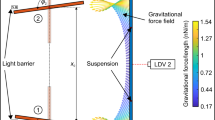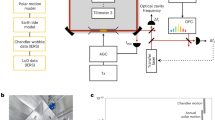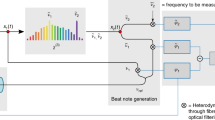Abstract
THE standard very-low-frequency 20-kc. emission from the National Bureau of Standards radio station WWVL at Sunset, Colorado, has been synchronized with the frequency of a working atomic standard located at the National Bureau of Standards Laboratories in Boulder, Colorado, eleven miles from the transmitter site. The phase-lock loop for this purpose uses a servosystem similar to that described by Looney1, with the system elements necessarily divided between the two locations. At Boulder Laboratories is located a 20-kc./s. receiver, phase detector, atomic standard and a 50 Mc./s. F.M. auxiliary transmitter for returning error and reference phase signals, by means of duplexing, to a 400 c.p.s. two-phase servomotor with gear reduction which drives a resolver at the transmitter site. The resolver, which is located electrically between the local crystal oscillator and transmitter input, thus corrects the transmitter input phase so as to maintain the transmitted output phase, as received at Boulder Laboratories, in synchronism with the phase of the controlling atomic oscillator. This system therefore corrects for frequency drift of the transmitter control oscillator as well as for changes in phase which in general are known to occur in the transmitter and antenna system (ref. 2 and Watt, A. D., private communication). Comparisons made on a very-low-frequency monitor between the phase of the received 20-kc./s. signal at Boulder Laboratories and that derived from the working atomic standard oscillator show that any uncorrected random phase variations may amount to no more than 0.05 µsec. phase shift so that transmitted phase stability is essentially that of the working atomic oscillator.
This is a preview of subscription content, access via your institution
Access options
Subscribe to this journal
Receive 51 print issues and online access
$199.00 per year
only $3.90 per issue
Buy this article
- Purchase on Springer Link
- Instant access to full article PDF
Prices may be subject to local taxes which are calculated during checkout
Similar content being viewed by others
References
Looney, Chesley H., Proc. Inst. Rad. Eng., 49, 448 (1961).
Watt-Carter, D. E., and Cork, R., L., Nature, 191, 1286 (1961).
Mockler, R. C., Beehler, R. E., and Snider, C. S., Trans. Inst. Rad. Eng., 1–9, 120 (1960).
Author information
Authors and Affiliations
Rights and permissions
About this article
Cite this article
FEY, R., MILTON, J. & MORGAN, A. Remote Phase Control of Radio Station WWVL. Nature 193, 1063–1064 (1962). https://doi.org/10.1038/1931063c0
Issue Date:
DOI: https://doi.org/10.1038/1931063c0
Comments
By submitting a comment you agree to abide by our Terms and Community Guidelines. If you find something abusive or that does not comply with our terms or guidelines please flag it as inappropriate.



